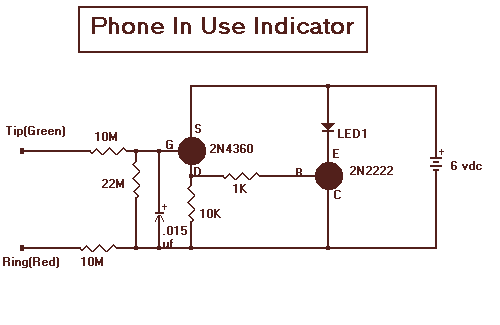
Telephone In Use Indicator Circuit

With this circuit mounted in or near every phone in the house, it will allow users to know if the phone is being used and not to pick up the phone. When a phone is taken off hook, the voltage across the tip and ring terminals drops to 10 volts or less. This will cause the FET (2N4360) to turn on and also turn on the transistor (2N2222). When the transistor turns on it will allow current to flow through the LED and make it light. A blinking LED could be used to make the effect better.
The circuit described functions as a phone usage indicator, providing a visual alert when a telephone line is in use. The primary components include a Field Effect Transistor (FET), specifically the 2N4360, and a Bipolar Junction Transistor (BJT), the 2N2222.
When the telephone is taken off the hook, the voltage across the tip and ring terminals diminishes to 10 volts or lower. This voltage drop is crucial as it serves as the triggering condition for the FET. The 2N4360 is configured such that its gate is connected to the telephone line, allowing it to turn on when the voltage falls below the specified threshold.
Once the FET is activated, it provides a path for current to flow to the base of the 2N2222 transistor. The 2N2222, once energized by the current from the FET, enters its active state, allowing a larger current to flow from the collector to the emitter. This current flow is what powers the LED, causing it to illuminate.
To enhance the visual indication, a blinking LED can be integrated into the circuit. This can be achieved by incorporating a timing circuit, such as a simple astable multivibrator configuration using additional components like resistors and capacitors, which will intermittently switch the LED on and off, drawing attention to the line status.
In summary, this circuit effectively utilizes the properties of both FETs and BJTs to create a straightforward and efficient phone usage indicator. The design allows for easy installation in proximity to telephones, ensuring that users are aware of the line status without needing to check the phone physically.With this circuit mounted in or near every phone in the house, it will allow users to know if the phone is being used and not to pick up the phone. When a phone is taken off hook, the voltage across the tip and ring terminals drops to 10 volts or less.
This will cause the FET (2N4360) to turn on and also turn on the transistor (2N2222). When the transistor turns on it will allow current to flow through the LED and make it light. A blinking LED could be used to make the effect better. 🔗 External reference
The circuit described functions as a phone usage indicator, providing a visual alert when a telephone line is in use. The primary components include a Field Effect Transistor (FET), specifically the 2N4360, and a Bipolar Junction Transistor (BJT), the 2N2222.
When the telephone is taken off the hook, the voltage across the tip and ring terminals diminishes to 10 volts or lower. This voltage drop is crucial as it serves as the triggering condition for the FET. The 2N4360 is configured such that its gate is connected to the telephone line, allowing it to turn on when the voltage falls below the specified threshold.
Once the FET is activated, it provides a path for current to flow to the base of the 2N2222 transistor. The 2N2222, once energized by the current from the FET, enters its active state, allowing a larger current to flow from the collector to the emitter. This current flow is what powers the LED, causing it to illuminate.
To enhance the visual indication, a blinking LED can be integrated into the circuit. This can be achieved by incorporating a timing circuit, such as a simple astable multivibrator configuration using additional components like resistors and capacitors, which will intermittently switch the LED on and off, drawing attention to the line status.
In summary, this circuit effectively utilizes the properties of both FETs and BJTs to create a straightforward and efficient phone usage indicator. The design allows for easy installation in proximity to telephones, ensuring that users are aware of the line status without needing to check the phone physically.With this circuit mounted in or near every phone in the house, it will allow users to know if the phone is being used and not to pick up the phone. When a phone is taken off hook, the voltage across the tip and ring terminals drops to 10 volts or less.
This will cause the FET (2N4360) to turn on and also turn on the transistor (2N2222). When the transistor turns on it will allow current to flow through the LED and make it light. A blinking LED could be used to make the effect better. 🔗 External reference
%2BCircuit%2Bdiagram%2Busing%2BCD4047%2Band%2BIRFZ44%2Bpower%2BMOSFET.png)




